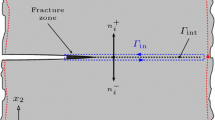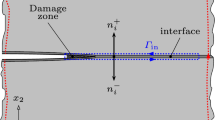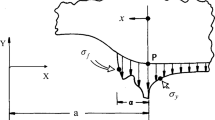Abstract
Based on the concept of configurational forces, the driving force of cracks in elastic–plastic, creeping materials is derived. In a numerical study, the variation of the crack driving force with increasing creep time is compared to the behaviors of different parameters that have been used in literature to describe the tendency to creep crack growth. This is performed for the assumption of stationary cracks in C(T)-specimens made of Waspaloy at 700 °C. The loading conditions are varied so that small-scale creep, transition creep, or extensive creep conditions prevail. Either the load or the load-point displacement are held constant. It is demonstrated that, for the considered cases, the conventional creep crack growth parameters do not reflect the crack driving force, but qualitatively follow a behavior similar to the (absolute value of the) time derivative of the crack driving force.













Similar content being viewed by others
Notes
A difference occurs only regarding the surface configurational force at the location of a traction vector t at a boundary, but the effects of opposite traction vectors compensate, see Fischer et al. (2012).
The path independence of \(J^{{{\text{nle}}}}\) is valid for an ideally sharp crack. If the crack blunts, a process zone appears at the crack tip where non-proportional loading conditions can prevail. This leads to a decrease of \(J^{{{\text{nle}}}}\) near the crack tip, \(J_{{\Gamma_{{\text{r}}} }}^{{{\text{nle}}}} \to 0\) for \(r \to 0\), see e.g. McMeeking (1977), Rice (1979), and Kolednik et al. (2014).
Note that the meaning of the term “crack driving force” differs for a cyclically loaded crack; its purpose is to allow the prediction of the crack propagation rate of a fatigue crack (Paris and Erdogan 1963).
In ABAQUS, the C*-integral according to Eq. (2) is denominated as Ct-integral. It is stated that Ct becomes path independent and is known as C*-integral for steady-state creep conditions. As for the computation of the computational J-integral, JVCE, the line integral of Eq. (2) is transformed into a domain integral for the evaluation.
A comparison of the strain energy density rate \(\dot{\phi }\) in the cases of F = 1 kN (Sect. 5.1) and V = 0.030 mm shows that, for F = 1 kN where the C*-integral is always positive, \(\dot{\phi }\) is always positive in front of the crack tip and decreases with increasing creep time. For V = 0.030 mm, negative \(\dot{\phi }\)-values appear in two regions near the back face of the specimen, above (and below) the crack plane. The expansion of these regions becomes smaller with increasing creep time. These findings explain why negative values of the C*-integral can appear for large contour radius R, compare Eq. (2).
References
Anderson TL (1995) Fracture mechanics, fundamentals and applications, 3rd edn. CRC Press, Boca Raton
ASTM E1457-00 (2000) Standard test method for measurement of creep crack growth rates in metals. In: Annual book of ASTM standards, vol 03.01. ASTM International, West Conshohocken
ASTM E1820-08 (2008) Standard test method for measurement of fracture toughness. In: Annual book of ASTM standards, vol 03.01. ASTM International, West Conshohocken
Bassani JL, McClintock FL (1981) Creep relaxation of stress around a crack tip. Int J Solids Struct 17:79–89
Bassani JL, Hawk DE, Saxena A (1988) Evaluation of Ct parameter for characterizing creep crack growth rate in the transient regime. ASTM STP 995:7–26
Ehlers R, Riedel H (1981) A finite element analysis of creep deformation in a specimen containing a macroscopic crack. In: Proceedings of the 5th international conference on fracture, 1981. Pergamon Press, Oxford, pp 691–698
Eshelby JD (1970) Energy relations and the energy–momentum tensor in continuum mechanics. In: Kanninen M, Adler W, Rosenfield A, Jaffee R (eds) Inelastic behavior of solids. McGraw-Hill, New York, pp 77–115
Fischer FD, Simha NK, Predan J, Schöngrundner R, Kolednik O (2012) On configurational forces at boundaries in fracture mechanics. Int J Fract 174:61–74
Gurtin ME (2000) Configurational forces as basic concepts of continuum physics. Springer, New York
Gurtin ME, Podio-Guidugli P (1996) Configurational forces and the basic laws for crack propagation. J Mech Phys Solids 44:905–927
Hide TH, Xia L, Becker AA (1996) Prediction of creep failure in aeroengine materials under multi-axial stress states. Int J Mech Sci 38:385–403
Hoff NJ (1954) Approximate analysis of structures in the presence of moderately large creep deformations. Q Appl Math 12:49–55
Hutchinson JW (1968) Singular behavior at the end of a tensile crack tip in a hardening material. J Mech Phys Solids 16:13–31
Kienzler R, Herrmann G (2000) Mechanics in material space. Springer, Berlin
Kolednik O, Predan J, Fischer FD (2010) Reprint of “Cracks in inhomogeneous materials: comprehensive assessment using the configurational forces concept.” Eng Fract Mech 77:3611–3624
Kolednik O, Schöngrundner R, Fischer FD (2014) A new view on J-integrals in elastic–plastic materials. Int J Fract 187:77–107
Kolednik O, Kasberger R, Sistaninia M, Predan J, Kegl M (2019) Development of damage-tolerant and fracture-resistant materials by utilizing the material inhomogeneity effect. ASME J Appl Mech 86:111004
Landes JD, Begley JA (1976) A fracture mechanics approach to creep crack growth. ASTM STP 590:128–148
Maugin GA (1994) Eshelby stress in elastoplasticity and ductile fracture. Int J Plast 10:393–408
Maugin GA (1999) The thermomechanics of nonlinear irreversible behaviors. World Scientific, Inc., London
Maugin GA (2011) Configurational forces: thermomechanics, physics, mathematics and numerics. CRC Press, Boca Raton
McMeeking RM (1977) Path dependence of the J-integral and the role of J as a parameter characterizing the near tip field. ASTM STP 631:28–41
Neate GJ (1986) Creep crack growth in 1/2Cr–Mo–V steel at 838 K, II: behaviour under displacement-controlled loading. Mater Sci Eng 82:77–84
Nikbin KM, Webster GA, Turner CE (1976) Relevance of nonlinear fracture mechanics to creep crack growth. ASTM STP 601:47–62
Nikbin KM, Smith DJ, Webster GA (1986) An engineering approach to the prediction of creep crack growth. J Eng Mater Technol 108:186–191
Ochensberger W, Kolednik O (2014) A new basis for the application of the J-integral for cyclically loaded cracks in elastic–plastic materials. Int J Fract 189:77–101
Ochensberger W, Kolednik O (2015) Physically appropriate characterization of fatigue crack propagation rate in elastic–plastic materials using the J-integral concept. Int J Fract 192:25–45
Ochensberger W, Kolednik O (2016) Overload effect revisited—investigation by use of configurational forces. Int J Fatigue 83:161–173
Ohji K, Ogura K, Kubo S (1976) Creep crack propagation rate in SUS 304 stainless steel and interpretation in terms of modified J-integral. Trans Jpn Soc Mech Eng 42:350–358
Ohji K, Ogura K, Kubo S (1979) Stress–strain fields and modified J-integral in the vicinity of the crack tip under transient creep conditions. Trans Jpn Soc Mech Eng 790:18–20 (in Japanese)
Paris PC, Erdogan F (1963) A critical analysis of crack propagation laws. J Basic Eng 85:528–534
Rakin M, Kolednik O, Medjo B, Simha NK, Fischer FD (2009) A case study on the effect of thermal residual stresses on the crack-driving force in linear-elastic biomaterials. Int J Mech Sci 51:531–540
Rice JR (1968) A path independent integral and the approximate analysis of strain concentration by notches and cracks. ASME J Appl Mech 35:379–386
Rice JR (1979) The mechanics of quasi-static crack growth. In: Kelly RE (ed) Proceedings of the eighth U.S. National Congress of Applied Mechanics. ASME, New York, pp 191–216
Rice JR, Rosengren GF (1968) Plane strain deformation near a crack tip in a power-law hardening material. J Mech Phys Solids 16:1–12
Riedel H (1987) Fracture at high temperatures. Springer, Berlin
Riedel H (1989) Creep crack growth. ASTM STP 1020:101–126
Riedel H, Rice JR (1980) Tensile cracks in creeping solids. ASTM STP 700:112–130
Saxena A (1980) Evaluation of C* for characterization of creep crack growth behavior of 304 stainless steel. ASTM STP 700:131–151
Saxena A (1986) Creep crack growth under non steady state conditions. ASTM STP 905:185–201
Saxena A (1991) Creep crack growth in ductile materials. Eng Fract Mech 40:721–736
Saxena A (2019) Advanced fracture mechanics and structural integrity. CRC Press, Boca Raton
Saxena A, Yagi K, Tabuchi M (1994) Crack growth under small scale and transition creep conditions in creep-ductile materials. ASTM STP 1207:481–497
Saxena A, Hall DE, McDowell DL (1999) Assessment of deflection rate partitioning for analyzing creep crack growth rate data. Eng Fract Mech 62:112–112
Simha NK, Fischer FD, Kolednik O, Chen CR (2003) Inhomogeneity effects on the crack driving force in elastic and elastic–plastic materials. J Mech Phys Solids 51:209–240
Simha NK, Fischer FD, Kolednik O, Predan J, Shan GX (2005a) Crack tip shielding due to smooth and discontinuous material inhomogeneities. Int J Fract 135:73–93
Simha NK, Kolednik O, Fischer FD (2005b) Material force models for cracks—influences of eigenstrains, thermal strains and residual stresses. In: Carpinteri A (ed) 11th International conference on fracture, Torino, Italy, Paper 5329
Simha NK, Fischer FD, Shan GX, Chen CR, Kolednik O (2008) J-integral and crack driving force in elastic–plastic materials. J Mech Phys Solids 56:2876–2895
Xia L, Becker AA, Hyde TH (1998) An assessment of the C* and KI parameters for predicting creep crack growth in a Ni-base superalloy (Waspaloy) at 700°C. Int J Fract 92:39–53
Acknowledgements
The authors acknowledge very helpful discussions with Professor F.D. Fischer, Institute of Mechanics, Montanuniversität Leoben. A.T. acknowledges discussions with Professor A. Saxena, School of Materials Science and Engineering, Georgia Institute of Technology. Financial support by the Austrian Federal Government (in particular from Bundesministerium für Verkehr, Innovation und Technologie and Bundesministerium für Wissenschaft, Forschung und Wirtschaft) represented by the Österreichische Forschungsförderungsgesellschaft mbH and the Styrian and the Tyrolean Provincial Government, represented by Steirische Wirtschaftsförderungsgesellschaft mbH and Standortagentur Tirol, within the framework of the COMET Funding Programme is gratefully acknowledged (Strategic Project P1.3-WP3).
Author information
Authors and Affiliations
Corresponding author
Additional information
Publisher's Note
Springer Nature remains neutral with regard to jurisdictional claims in published maps and institutional affiliations.
Rights and permissions
About this article
Cite this article
Kolednik, O., Tiwari, A., Posch, C. et al. Configurational force based analysis of creep crack growth. Int J Fract 236, 175–199 (2022). https://doi.org/10.1007/s10704-022-00645-z
Received:
Accepted:
Published:
Issue Date:
DOI: https://doi.org/10.1007/s10704-022-00645-z




